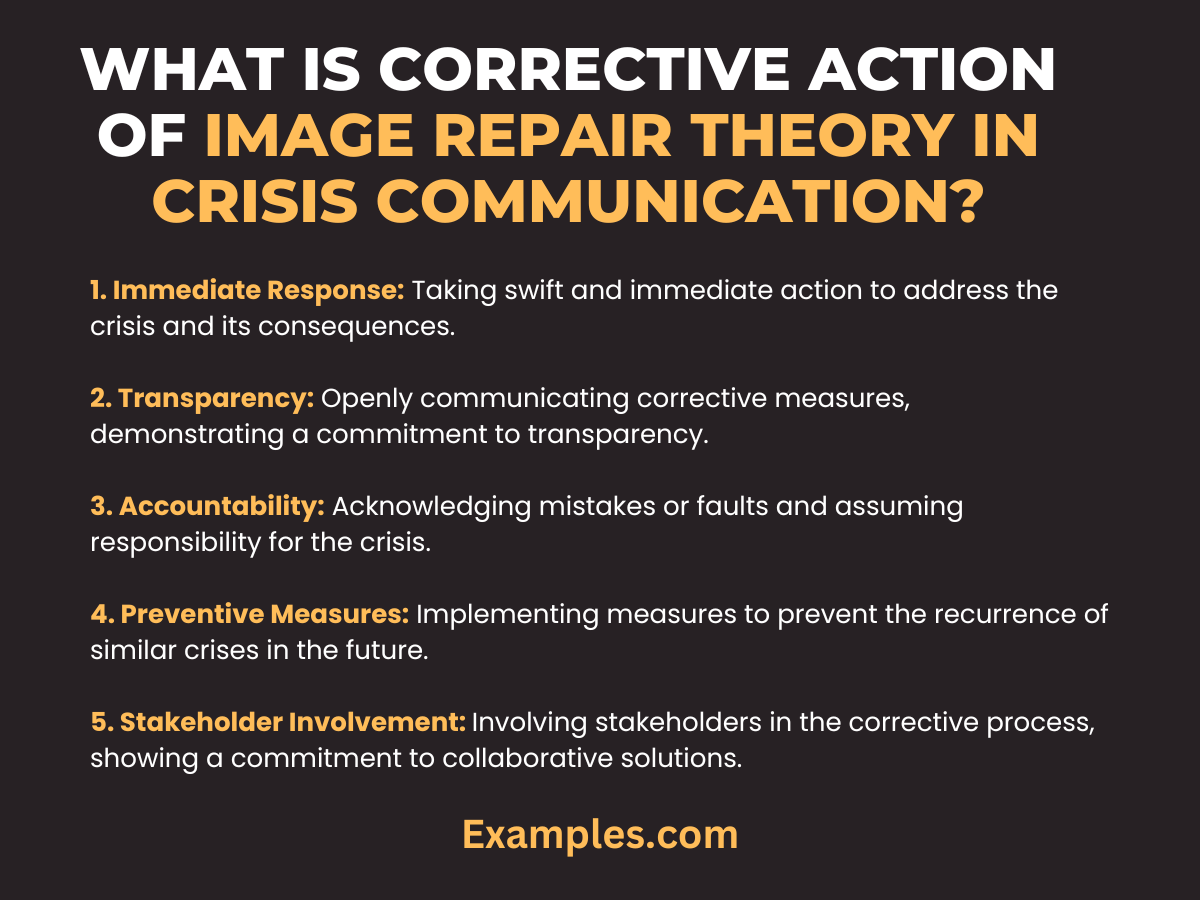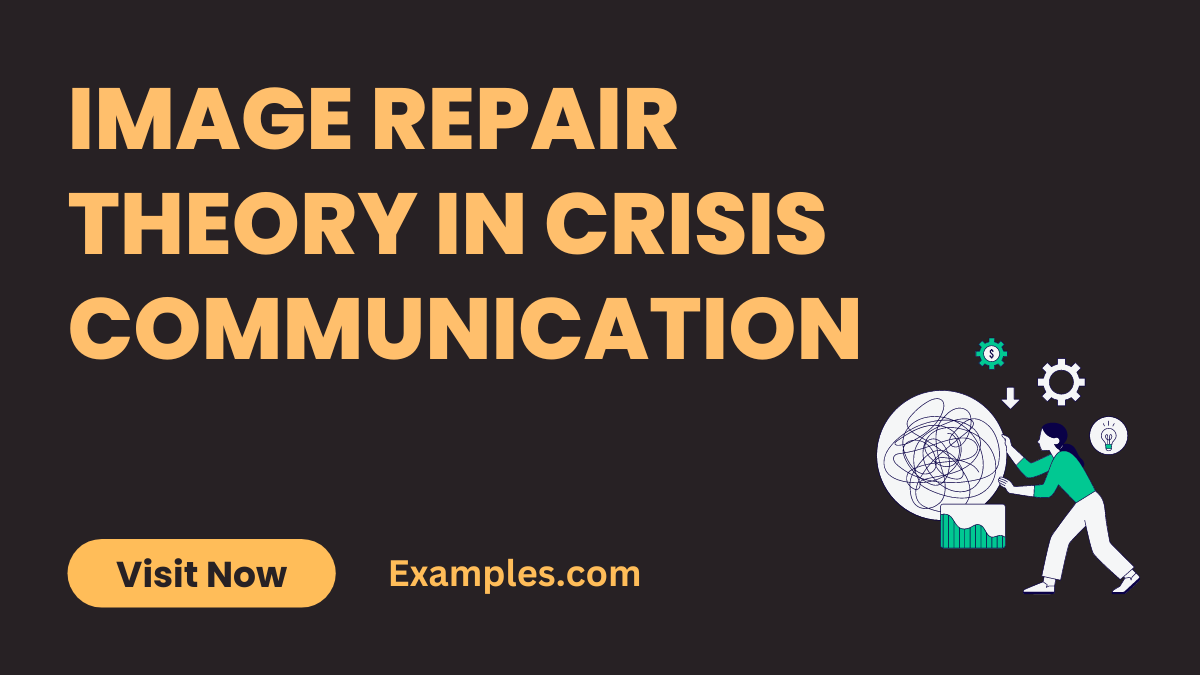Image Repair Theory in Crisis Communication
Embark on a comprehensive exploration of Image Repair Theory in Crisis Communication with our detailed guide. Uncover the intricacies of strategic communication during challenging times, enriched with real-world examples. This comprehensive resource equips you with the essential tools to navigate crises effectively, employing Image Repair Theory to reshape perceptions and foster communication examples that stand as pillars of reputation restoration. Elevate your crisis communication skills with actionable insights and proven strategies.
What is Image Repair Theory in Crisis Communication?

Image Repair Theory in Crisis Communication is a strategic framework designed to help individuals or organizations mend their damaged reputation following a crisis. In simple terms, it outlines techniques and strategies to address negative perceptions, offering a roadmap for rebuilding trust and credibility. By understanding and applying Image Repair Theory, communicators can navigate crises more effectively, crafting messages that not only acknowledge faults but also work towards restoring a positive public image.
20 Image Repair Theory in Crisis Communication Examples

Explore 20 real-world examples illustrating the application of Image Repair Theory in crisis communication. This curated collection offers insights into strategic communication techniques, providing a diverse range of cases where organizations effectively repaired their damaged reputation. Each example unveils key principles of Image Repair Theory, offering valuable lessons for communicators navigating challenging situations.
- Product Recall Apology: Swiftly address the issue, apologize sincerely, and present concrete steps taken to prevent future recalls.
- Leadership Misconduct Acknowledgment: Transparently admit fault, express regret, and outline leadership changes and reforms.
- Environmental Responsibility Pledge: Showcase commitment to sustainability, detail environmental initiatives, and emphasize continuous improvement.
- Financial Transparency Communication: Communicate financial challenges openly, provide a clear action plan for recovery, and reassure stakeholders.
- Customer Service Overhaul: Acknowledge service shortcomings, apologize, and introduce enhanced customer service measures.
- Data Security Breach Response: Assure affected parties, detail security improvements, and offer compensation for any damages incurred.
- Employee Treatment Reformation: Publicly address employee concerns, implement changes, and emphasize a renewed commitment to staff well-being.
- Community Engagement Initiatives: Showcase involvement in community projects, emphasizing the positive impact and commitment to social responsibility.
- Brand Perception Transformation: Launch a rebranding campaign, emphasizing a renewed identity and commitment to customer satisfaction.
- Crisis Transparency Podcast: Share a series of podcasts discussing the crisis, demonstrating openness, and providing regular updates.
- Educational Outreach Program: Develop educational initiatives related to the crisis, showcasing efforts to prevent similar incidents in the future.
- Government Relations Improvement: Establish better relations with regulatory bodies, ensuring compliance, and addressing concerns collaboratively.
- Proactive Social Media Response: Monitor and address negative comments on social media promptly, showcasing responsiveness and commitment to improvement.
- Supplier Accountability Communication: Hold suppliers accountable for their role in the crisis, outline corrective actions, and communicate measures taken.
- Stakeholder Dialogue Forums: Conduct open forums engaging with stakeholders, fostering transparency and addressing concerns directly.
- Diversity and Inclusion Initiatives: Implement measures to enhance diversity and inclusion, emphasizing an inclusive organizational culture.
- Investor Confidence Rebuilding: Communicate a clear vision for recovery, detailing financial strategies, and demonstrating commitment to shareholder interests.
- Crisis Impact Reports: Release comprehensive reports detailing the crisis’s impact, outlining lessons learned, and steps taken for improvement.
- Employee Empowerment Campaign: Highlight efforts to empower and involve employees in decision-making, fostering a sense of belonging.
- Crisis Documentary Production: Create a documentary showcasing the crisis journey, emphasizing the organization’s commitment to transparency and change.
Image Repair Theory in Crisis Communication Examples for Student
Discover impactful Image Repair Theory examples tailored to student scenarios. This guide unravels how educational institutions navigate crises, applying strategic communication to repair reputation and foster understanding.
- Plagiarism Scandal Acknowledgment: Address the incident, express remorse, and implement enhanced plagiarism prevention measures.
- Faculty-Student Dispute Resolution: Facilitate open dialogue, address concerns, and highlight measures to improve faculty-student relations.
- Curriculum Mismanagement Rectification: Apologize for any disruptions, communicate curriculum improvements, and involve students in decision-making.
- Student Protest Response: Acknowledge concerns, engage in constructive dialogue, and outline steps taken to address student grievances.
- University Brand Alignment Campaign: Launch a campaign emphasizing the institution’s commitment to student welfare and educational excellence.
Image Repair Theory in Crisis Communication Examples for Business
Explore real-world business scenarios where Image Repair Theory shines. This guide unveils strategic communication approaches, showcasing how enterprises effectively navigate crises, rebuild trust, and reshape their public image.
- Product Quality Recall Communication: Swiftly recall products, communicate quality improvements, and offer compensation to affected customers.
- Workplace Diversity Enhancement: Acknowledge diversity challenges, detail inclusion initiatives, and showcase a commitment to fostering a diverse workplace.
- Executive Misconduct Address: Transparently address executive misconduct, outline corrective actions, and reaffirm commitment to ethical leadership.
- Financial Transparency Seminar: Conduct seminars on financial challenges, share recovery plans, and assure stakeholders of improved financial management.
- Brand Perception Turnaround Campaign: Launch a campaign highlighting a redefined brand identity, emphasizing positive changes, and engaging with customers for feedback.
What are Image Repair Theory in Crisis Communication Strategies?
Image Repair Theory offers nuanced strategies for crisis communication:
- Denial: Initially, organizations may deny the allegations or crisis, questioning the accuracy of claims.
- Evasion of Responsibility: Shifting blame or minimizing responsibility is a common strategy to deflect negative perceptions.
- Reducing Offensiveness: Acknowledge wrongdoing while downplaying its severity, aiming to minimize the perceived harm.
- Corrective Action: Demonstrating tangible steps taken to rectify the situation and prevent future occurrences.
- Bolstering: Emphasizing positive aspects of the organization to counterbalance negative perceptions.
- Differentiation: Highlighting distinctions between the current crisis and past incidents to mitigate perceived similarities.
- Mortification: Offering sincere apologies and accepting full responsibility, expressing genuine remorse.
What is the Role of Image Repair Theory in Crisis Communication?
Image Repair Theory plays a pivotal role in crisis communication:
- Strategic Response Framework: Image Repair Theory provides a structured approach for organizations to strategically respond to crises.
- Rebuilding Trust: By offering systematic strategies, it aids in rebuilding trust and credibility damaged during a crisis.
- Tailored Communication: Guides communicators in tailoring messages based on the nature and severity of the crisis, ensuring relevance.
- Preventing Escalation: Helps in preventing the escalation of negative perceptions and the potential fallout from a crisis.
- Fostering Understanding: Plays a crucial role in fostering public understanding by addressing concerns transparently and authentically.
What is Corrective Action of Image Repair Theory in Crisis Communication?

Corrective Action is a crucial facet of Image Repair Theory:
- Immediate Response: Taking swift and immediate action to address the crisis and its consequences.
- Transparency: Openly communicating corrective measures, demonstrating a commitment to transparency.
- Accountability: Acknowledging mistakes or faults and assuming responsibility for the crisis.
- Preventive Measures: Implementing measures to prevent the recurrence of similar crises in the future.
- Stakeholder Involvement: Involving stakeholders in the corrective process, showing a commitment to collaborative solutions.
- Continuous Improvement: Image Repair Theory emphasizes continuous learning and improvement, ensuring organizations evolve based on crisis experiences.
In conclusion, this comprehensive guide has unraveled the intricacies of Image Repair Theory in Crisis Communication. Armed with strategic insights and real-world examples, communicators are empowered to navigate crises effectively. From tailored strategies to corrective actions, this guide serves as a beacon for reputation restoration. Mastering Image Repair Theory ensures a resilient approach to crisis communication, safeguarding organizational integrity and fostering lasting public trust.



